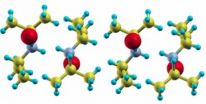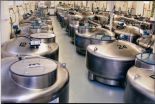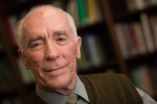(Press-News.org) The electronics industry has a remarkable impact on the environment, yet research is devising new solutions to reduce it. Among these, a new compound with an unutterable name, the diisopropylammonium bromide (DIPAB), a new ferroelectric material created by an international team of researchers that include Massimo Capone and Gianluca Giovannetti of Istituto Officina dei Materiali at CNR and of the International School for Advanced Studies of Trieste (SISSA), whose research has been just published in Science magazine.
"A ferroelectric material has properties analogous to those of a magnet in electricity, a system in which the electric dipoles tend to 'line up'" explains Capone. Materials with such characteristics are key in the production of electronic devices, from ordinary computers to solar cells. The materials that are usually employed, like barium or titanium oxides, have a very strong impact on the environment and, besides, require complex equipment for their production. "This is not the case of the organic compound we have elaborated and studied, that can be processed very easily from aqueous solution and has a low impact on the environment" comments Giovannetti. And not only it is environmentally friendlier, but also cheaper.
By improving its response at the processing stage, the use of such material may spread to the field of electronic devices. The theoretical study carried out by Giovannetti and Capone aims at identifying new materials with even better characteristics and to fine-tune their processing. "The process currently employed still shows some small errors, that is, exhibits a percentage of processed molecules that differs from what expected", points out Capone. "By improving such aspect DIPAB may be employed in the future in the production, for instance, of computer memory."
More in detail...
DIPAB is defined as a molecular crystal. What does that mean? "Basically it is a lattice in which at each point, instead of a single atom, as observed in normal crystals, an entire molecule is found," explains Capone. "This is a crucial aspect, as such molecules feature 'tails' that can orient themselves much more easily than what occurs with ions in atomic crystals, thus favouring polarization." Capone, supported by the European Research Council ERC through a prestigious "Starting Grant", believes that the DIPAB processing is only a starting point, and that molecular compounds may replace oxides in several other fields of application, including devices based on superconductors.
INFORMATION:
A new material for environmentally friendlier electronics
A new organic 'ferroelectric,' economical and with low environmental impact, has been created
2013-01-28
ELSE PRESS RELEASES FROM THIS DATE:
A safer way to vaccinate
2013-01-28
CAMBRIDGE, MA -- Vaccines usually consist of inactivated viruses that prompt the immune system to remember the invader and launch a strong defense if it later encounters the real thing. However, this approach can be too risky with certain viruses, including HIV.
In recent years, many scientists have been exploring DNA as a potential alternative vaccine. About 20 years ago, DNA coding for viral proteins was found to induce strong immune responses in rodents, but so far, tests in humans have failed to duplicate that success.
In a paper appearing in the Jan. 27 online ...
Some health benefits of berries may not make it past your mouth
2013-01-28
COLUMBUS, Ohio – Research has suggested that compounds that give colorful fruits their rich hues, especially berries, promote health and might even prevent cancer. But for the first time, scientists have exposed extracts from numerous berries high in those pigments to human saliva to see just what kinds of health-promoting substances are likely to survive and be produced in the mouth.
It's too early to name the best berry for health promotion based on this initial work. But the researchers have discovered that two families of pigments that provide berries with their colors, ...
Soya protein can be replaced by rapeseed protein
2013-01-28
Jena (Germany) Today, more than 500 million people are suffering from a lack of adequate protein in their diet. Each year, the number of human beings increases by 80 million, a figure which is equivalent to the present population of Germany. Thus, providing enough food, particularly sufficient protein for the increasing populace is a challenging task for societies all over the world. On a prospective basis, a progressively smaller proportion of human protein requirement can be provided by animal proteins such as meat, eggs, and milk. "However, by feeding valuable plant ...
Study of human specimen collections in the US offers first look at their huge diversity
2013-01-28
Chapel Hill, N.C. – Biobanks are organizations that collect, store and share human specimens (e.g., blood, solid tissues, hair) for research purposes. The rise of the human genome project and of large-scale genetics studies have spurred a dramatic increase in the number of biobanks in the last decade, increasing their importance in biomedical research.
But until now, biobanks in the U.S. have never been studied systematically, leaving few clear details as to how they are run or the policies and practices they use in managing their work.
A new study from the University ...
Discovering the missing 'LINC' to deafness
2013-01-28
Tel Aviv — Because half of all instances of hearing loss are linked to genetic mutations, advanced gene research is an invaluable tool for uncovering causes of deafness — and one of the biggest hopes for the development of new therapies. Now Prof. Karen Avraham of the Sackler Faculty of Medicine at Tel Aviv University has discovered a significant mutation in a LINC family protein — part of the cells of the inner ear — that could lead to new treatments for hearing disorders.
Her team of researchers, including Dr. Henning Horn and Profs. Colin Stewart and Brian Burke of ...
With hot air treatment, bacteria fly the coop
2013-01-28
This press release is available in Spanish.Poultry producers can reduce bacterial cross-contamination in poultry cages by treating the cages with forced air that's been heated to 122 degrees Fahrenheit, according to a study by U.S. Department of Agriculture (USDA) scientists.
While being transported in coops on trucks, poultry that have bacteria such as Campylobacter can contaminate, through their feces, other poultry that are free of pathogens. Those disease-causing bacteria can then be passed on to the next group of birds during the next trip, and so forth, unless ...
Islet transplant may slow progression of atherosclerosis
2013-01-28
Minimally invasive islet transplantation for patients with type 1 diabetes achieves insulin independence and reverses the progression of atherosclerosis in the first few years after transplant, according to a University of Illinois at Chicago study.
The research is published in the February issue of the journal Diabetes Care and is available online.
Patients with diabetes, particularly women, have a substantial increased risk of dying from ischemic heart disease, according to previous research. However, future cardiac events may be prevented with intensive glycemic ...
Central Valley irrigation intensifies rainfall, storms across the Southwest
2013-01-28
Irvine, Calif., Jan. 28, 2013 – Agricultural irrigation in California's Central Valley doubles the amount of water vapor pumped into the atmosphere, ratcheting up rainfall and powerful monsoons across the interior Southwest, according to a new study by UC Irvine scientists.
Moisture on the vast farm fields evaporates, is blown over the Sierra Nevada and dumps 15 percent more than average summer rain in numerous other states. Runoff to the Colorado River increases by 28 percent, and the Four Corners region experiences a 56 percent boost in runoff. While the additional ...
Safeguards needed for tissue donors
2013-01-28
Donors to biobanks – vast collections of human tissue samples that scientists hope will lead to new treatments for diseases – have a right to basic information about how their donations may be used, a Michigan State University ethicist argues in a new paper.
The idea behind biobanks is that a repository with hundreds of thousands of samples, each linked to medical records and other health information, can yield discoveries smaller data sets can't match. Once samples are collected, researchers in many fields can use the data repeatedly.
"More and larger biobanks are ...
New LGBT Health journal launching in 2013
2013-01-28
New Rochelle, NY, January 28, 2013—Over 4 million adults in the United States identify as gay, lesbian, or bisexual and approximately 700,000 identify as transgender. An NIH-sponsored investigation by the Institute of Medicine (IOM) concluded that the health status and healthcare needs of this sizable population are poorly understood and likely inadequately met. A journal is urgently needed to support, promote, and address the unique healthcare needs of each population that comprises the LGBT community, in the United States and worldwide. LGBT Health, a new peer-reviewed ...
LAST 30 PRESS RELEASES:
Manta rays create mobile ecosystems, study finds
Study: Mixed results in using lipoic acid to treat progressive multiple sclerosis
Norbert Holtkamp appointed director of Fermi National Accelerator Laboratory
New agentic AI platform accelerates advanced optics design
Biologists discover neurons use physical signals — not electricity — to stabilize communication
Researchers discover that a hormone can access the brain by hitchhiking
University of Oklahoma researcher awarded funding to pursue AI-powered material design
Exploring how the visual system recovers following injury
Support for parents with infants at pediatric check-ups leads to better reading and math skills in elementary school
Kids’ behavioral health is a growing share of family health costs
Day & night: Cancer disrupts the brain’s natural rhythm
COVID-19 vaccination significantly reduces risk to pregnant women and baby
The role of vaccination in maternal and perinatal outcomes associated with COVID-19 in pregnancy
Mayo Clinic smartwatch system helps parents shorten and defuse children's severe tantrums early
Behavioral health spending spikes to 40% of all children’s health expenditures, nearly doubling in a decade
Digital cognitive behavioral treatment for generalized anxiety disorder
Expenditures for pediatric behavioral health care over time and estimated family financial burden
Air conditioning in nursing homes and mortality during extreme heat
The Alps to lose a record number of glaciers in the next decade
What makes a good proton conductor?
New science reporting guide published for journalists in Bulgaria
New international study reveals major survival gaps among children with cancer
New science reporting guide published for journalists in Turkey
Scientists develop a smarter mRNA therapy that knows which cells to target
Neuroanatomy-informed brain–machine hybrid intelligence for robust acoustic target detection
Eight SwRI hydrogen projects funded by ENERGYWERX
The Lundquist Institute and its start-up company Vitalex Biosciences Announces Strategic Advancement of Second-Generation fungal Vaccine VXV-01 through Phase 1 Trials under $40 Million Competitive Con
Fine particles in pollution are associated with early signs of autoimmune disease
Review article | Towards a Global Ground-Based Earth Observatory (GGBEO): Leveraging existing systems and networks
Penn and UMich create world’s smallest programmable, autonomous robots
[Press-News.org] A new material for environmentally friendlier electronicsA new organic 'ferroelectric,' economical and with low environmental impact, has been created




